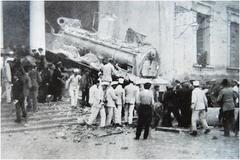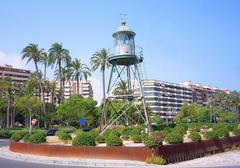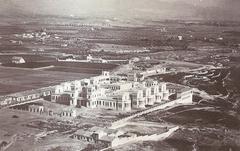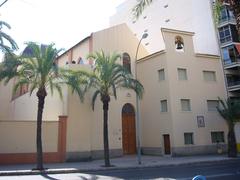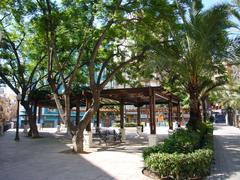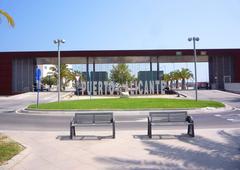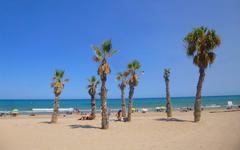Torre Cacholí: Visiting Hours, Tickets, and Historical Sites Guide
Date: 14/06/2025
Introduction
Torre Cacholí, nestled in the fertile Huerta de Alicante north of Alicante city, stands as a testament to the region’s rich history and architectural resilience. As one of the “Torres de la Huerta,” a network of defensive towers built primarily in the 16th and 17th centuries, Torre Cacholí played a crucial role in protecting Alicante’s agricultural landscape from Barbary corsair raids. Though interior access is currently limited due to private ownership and preservation concerns, the tower remains a poignant symbol within local heritage trails and cycling routes, offering visitors a unique lens into Alicante’s storied past (viewfromlavila.com; alicanteturismo.com).
This comprehensive guide details Torre Cacholí’s historical context, architectural features, preservation status, practical visitor information, and its integration with other notable Alicante historical sites. Whether you are a history enthusiast or a casual traveler, this resource will help you plan a meaningful and responsible visit.
Table of Contents
- Introduction
- Historical Context and Origins
- Architectural Features
- Strategic Importance
- Evolution and Preservation
- Restoration Challenges
- Visiting Information
- Cultural Significance
- Notable Facts
- FAQ
- Visuals & Maps
- Related Historical Sites
- Responsible Tourism
- Conclusion
- References
Historical Context and Origins
Torre Cacholí forms part of the “Torres de la Huerta,” a distinctive network of defensive towers erected during the 16th and 17th centuries. These towers were built to protect local farmers and landowners from the threat of Barbary corsair raids, which plagued Spain’s Mediterranean coasts (viewfromlavila.com). Positioned strategically across the fertile Huerta de Alicante, these towers utilized smoke and fire signals for rapid communication, providing early warnings and refuge for the local population (alicanteturismo.com).
Architectural Features
Torre Cacholí exemplifies robust 16th-century military engineering, constructed from local limestone and lime mortar. Its thick walls—over one meter wide—were designed to resist both projectiles and the elements. The tower’s entrance was elevated and accessible only by removable ladders for security. The interior typically included storage on the lower floor and living quarters above, with a rooftop terrace for observation and signaling (todoalicante.es).
Key elements:
- Cylindrical or slightly tapered structure
- Narrow observation slits
- Elevated, secure entry
- Interior chambers for refuge and storage
Strategic Importance
Torre Cacholí and its sister towers formed an overlapping network of line-of-sight defenses, connecting local farmsteads to the main city fortifications like Castillo de Santa Bárbara (en.wikipedia.org). These towers significantly reduced the success of pirate raids and helped safeguard the region’s agricultural productivity and population.
Evolution and Preservation
As corsair threats diminished in the late 17th century, many towers, including Torre Cacholí, were integrated into agricultural estates or repurposed for residential use. Urbanization in the 20th century led to the loss or deterioration of several towers, but around 20 of the original 30 structures survive (viewfromlavila.com). Torre Cacholí’s preservation status varies, with ongoing challenges from vandalism, environmental exposure, and limited resources for restoration.
Restoration Challenges
Torre Cacholí is listed on Hispania Nostra’s “Red List” as an endangered heritage site, underscoring the urgency for preservation (todoalicante.es). Restoration efforts prioritize minimal intervention and the use of traditional materials to maintain historical integrity (archdaily.com). However, funding and political support remain obstacles to comprehensive restoration projects.
Visiting Information
Hours & Tickets
- Visiting Hours: There are no official hours; daylight visits are recommended.
- Tickets: No entry fee is required for exterior viewing; the interior is not open to the public.
- Guided Tours: Occasionally, guided walking or cycling tours include Torre Cacholí as part of the Torres de la Huerta route. Special access may be granted during heritage events (thecostablancaguide.com).
Accessibility
- Approach: Access via flat, paved paths suitable for most visitors, including those with limited mobility, though some sidewalk sections may be uneven.
- Facilities: No on-site amenities; restrooms and refreshments are available in nearby San Juan district.
Directions
- Location: Camino de la Cruz de Piedra a San Juan, 8, northeast of Alicante city center. UTM coordinates: 30S 722894 4250791 (Alicante City Council PDF).
- By Car: Parking is available in surrounding neighborhoods.
- By Public Transport: Tram and bus lines run to San Juan; walking or cycling from there is recommended.
- By Bicycle/On Foot: Well-signposted as part of the “Ruta de las Torres de la Huerta” (Ocio Alicante).
Cultural Significance
Torre Cacholí is not only a monument to Alicante’s defensive ingenuity but also a symbol of local identity and rural resilience. The tower features in community events, educational programs, and heritage routes, connecting visitors and residents alike to the area’s layered history (alicanteturismo.com). Its presence has influenced the development of roads, neighborhoods, and cultural celebrations.
Notable Facts
- Constructed: 16th–17th centuries
- Surviving towers: About 20 out of an original 30
- Height: 10–15 meters
- Wall thickness: Over 1 meter
- Function: Coastal defense and refuge
- Status: Privately owned, no interior access
Frequently Asked Questions (FAQ)
Q: What are the visiting hours?
A: There are no official hours; daylight visits are safest.
Q: Do I need a ticket?
A: No; exterior visits are free.
Q: Can I enter the tower?
A: No; interior access is restricted due to private ownership and safety concerns.
Q: Is the site accessible?
A: The exterior is accessible via flat paths, suitable for most visitors.
Q: Are there guided tours?
A: Occasionally, as part of the Torres de la Huerta route or during special events.
Visuals & Maps
- High-quality images and interactive maps are available on official tourism websites and the Alicante City Council PDF.
- Alt text suggestions: “Torre Cacholí historic tower in Alicante,” “Exterior view of Torre Cacholí on the Torres de la Huerta route.”
Related Historical Sites
- Castillo de Santa Bárbara: Majestic hilltop fortress overlooking Alicante.
- Basilica of Santa Maria: The city’s oldest church.
- Other Huerta Towers: Torre de Rejas, Torre del Soto, Villa García—each with its own history.
Combine visits for a richer cultural itinerary (ourspanishadventures.com).
Responsible Tourism
- Respect private property: View the tower from public areas only.
- Leave no trace: Take litter with you and avoid disturbing the environment.
- Support preservation: Engage with or donate to organizations like Hispania Nostra (todoalicante.es).
Conclusion
Torre Cacholí remains a compelling emblem of Alicante’s maritime defense and agricultural heritage. Its robust architecture and strategic siting reflect centuries of local ingenuity and resilience. While interior access is not available, the tower’s exterior and its place along the Torres de la Huerta route make it a worthwhile stop for history lovers and outdoor enthusiasts alike. For the best experience, visit during spring or autumn, consult official resources for updates, and consider joining a guided route to enrich your understanding.
Download the Audiala app for interactive maps, expert guides, and real-time updates on Alicante’s historic sites. Follow us on social media and check our related articles for further inspiration.
References
- View from La Vila – Las Torres de la Huerta
- Todo Alicante – Heritage Ruins
- Alicante Turismo – Monuments and Historical Heritage
- Costa Blanca Guide – Alicante Bicycle Tour
- Wikipedia – History of Alicante
- ArchDaily – Restoration as a Method of Revalorizing Built Heritage in Spain
- Alicante City Council PDF – Torres de la Huerta
- Ocio Alicante – Ruta de las Torres de la Huerta
- Our Spanish Adventures – 1 Day Alicante Itinerary
